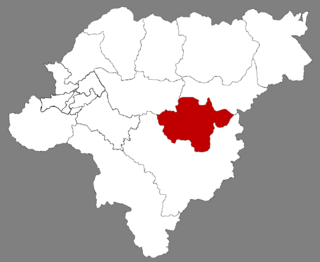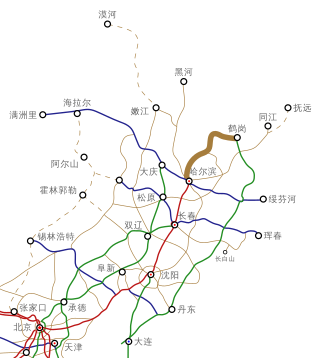
Harbin is a sub-provincial city and the provincial capital and the largest city of Heilongjiang province, People's Republic of China, as well as the second largest city by urban population after Shenyang and largest city by metropolitan population in Northeast China. Harbin has direct jurisdiction over nine metropolitan districts, two county-level cities and seven counties, and is the eighth most populous Chinese city according to the 2020 census. The built-up area of Harbin had 5,841,929 inhabitants, while the total metropolitan population was up to 10,009,854, making it one of the 50 largest urban areas in the world.

Qiqihar is the second-largest city in the Heilongjiang province of China, in the west central part of the province. The built-up area made up of Longsha, Tiefeng and Jianhua districts had 959,787 inhabitants, while the total population of the prefecture-level city was shrinking to 4,067,489 as of the 2020 census. These are mainly Han Chinese, though the city is also home to thirty-four minorities including Manchus, Daur, and Mongols.
Harbin Aircraft Industry (Group) Co., Ltd. (HAIG), often shortened to Hafei, is an aircraft manufacturing company headquartered in Pingfang District, Harbin, Heilongjiang province, China. It was previously called Harbin Aircraft Manufacturing Corporation (HAMC) in English.
Harbin Brewery is a Chinese brewery founded in 1900 in Harbin, China. As China's fourth largest brewery and its oldest one, it has a leading position in Northeast China and owns the Hapi beer brand.

Chinese sausage is a generic term referring to the many different types of sausages originating in China. The southern flavor of Chinese sausage is commonly known by its Cantonese name lap cheong.

Acheng District is one of nine districts of the prefecture-level city of Harbin, the capital of Heilongjiang Province, Northeast China, covering part of the southeastern suburbs. The district was approved to establish from the former Acheng City (阿城市) by the Chinese State Council on August 15, 2006. As of 2010, it had a population of 596,856 residing in an area of 2,680 km2 (1,030 sq mi), and is 29 km (18 mi) southeast of downtown Harbin, 190 km (120 mi) north of Jilin City, and around 50 km (31 mi) south of the Songhua River. It lies within the basin of and until 1909 was considered synonymous with the Ashi River which gave its name to the Jurchen Jin Dynasty. The district administers nine subdistricts, eight towns, one township, and one ethnic township. It borders Daowai District to the north, Bin County to the northeast, Shangzhi to the southeast, and Wuchang to the south, Shuangcheng District to the west, and Pingfang and Xiangfang Districts to the northwest.

Nangang District is one of nine districts of the prefecture-level city of Harbin, the capital of Heilongjiang Province, Northeast China, forming part of the city's urban core. It is home to major offices of the provincial government and is the political heart of Heilongjiang province. Other areas of interest within the district are the Harbin Railway Station, Guomao underground shopping street, a Confucian temple and the Buddhist Jile Temple. By far the most populous and densely populated of Harbin's county-level divisions, it borders the districts of Daowai and Xiangfang to the northeast, Pingfang to the southeast, Shuangcheng to the south, and Daoli to the west. A new subway system is also being built currently.

Harbin Taiping International Airport is the international airport serving Harbin, Heilongjiang Province. The airport handled 20,431,432 passengers in 2018, making it the 20th busiest airport in mainland China.

Yilan County is a county of Heilongjiang Province, Northeast China, it is under the administration of the prefecture-level city of Harbin, the capital of Heilongjiang. It is more than 240 kilometres (150 mi) to the east-northeast of central Harbin. Its county seat, which is also called Yilan, is located near the confluence of the Mudan River with the Sungari. The easternmost county-level division of Harbin City, it borders Fangzheng County to the southwest, Tonghe County to the west, as well as the prefecture-level cities of Yichun to the north, Jiamusi to the northeast, Qitaihe to the southeast, and Mudanjiang to the south.

The Cathedral of the Sacred Heart of Jesus is a Roman Catholic church in Harbin, Heilongjiang Province, China. Its official name is Sacred Heart of Jesus Diocesan Cathedral of Harbin.
Harbin Bank Co., Ltd. is a Chinese city-based commercial bank, with its headquarters in Harbin, Heilongjiang Province. It was established in 1997 as Harbin City Commercial Bank, opened its branches in Harbin City only, but changed its name to Harbin Bank in 2007 and has since opened branches in Dalian, Tianjin, Shuangyashan and Jixi. It ranks 4th by Comprehensive competitiveness among Chinese city commercial banks in 2011.

Yanshou County is a county of Heilongjiang Province, Northeast China, it is under the administration of the prefecture-level city of Harbin, the capital of Heilongjiang. It borders Fangzheng County to the north, Shangzhi to the south, and Bin County to the northwest.

Harbin railway station is a railway station on the Jingha railway, Binsui Railway, Labin Railway, Binbei Railway and Binzhou Railway. The station is in Nangang District, Harbin, Heilongjiang, China.

Harbinxi (West) railway station is a railway station on the Jingha Railway and the Harbin–Dalian section of the Beijing–Harbin High-Speed Railway. It is located in Harbin, in the Heilongjiang province of China.

The Hegang–Harbin Expressway, commonly referred to as the Heha Expressway is an expressway that connects the cities of Hegang, Heilongjiang, China, and Harbin, Heilongjiang. The expressway is a spur of G11 Hegang–Dalian Expressway.
Harbin–Mudanjiang intercity railway is a high-speed railway in Heilongjiang Province, China, between the cities Harbin and Mudanjiang. It is a Passenger Dedicated Line (PDL), with a design speed of 250 km/h (155 mph) and a total length 293.2 km (182.2 mi). Starting in Harbin, it leads east to Acheng, into mountains at Mao'ershan, to Shangzhi, again through the mountains to the southeast, Weihe, Yabuli, Hengdaohezi, Hailin and on to the end at Mudanjiang station. Future proposals for this line could see it extended across the border into Russia and the Russian port city of Vladivostok.
The 6021/6022 Jilin-Harbin Through Train is a Chinese passenger train service running between Jilin City to Harbin, capital of Heilongjiang express passenger trains by the Shenyang Railway Bureau, Jilin passenger segment responsible for passenger transport task, Jilin originating on the Harbin train. 25B Type Passenger trains running along the Jishu Railway and Labin Railway across Heilongjiang, Jilin and other provinces and cities, the entire 284 km. Jilin Railway Station to Harbin East Railway Station running 6 hours and 37 minutes, use trips for 6021; Harbin East Railway Station to Jilin Railway Station to run 6 hours and 55 minutes, use trips for 6022.

Dalieba or Lieba is a Chinese bread similar to Russian rye bread available in Northeast China.
Harbin Northern Forest Zoo, formerly Harbin Zoo, is the main zoological garden in Harbin. Occupying an area of 558 hectares, it is the largest forest zoo in China. Several endangered animal species are preserved in the zoo, including Siberian tiger, white lion and red-crowned crane.

Harbin Symphony Orchestra is a Chinese symphony orchestra based in Harbin, Heilongjiang, China. The orchestra's home is the Harbin Concert Hall.




















